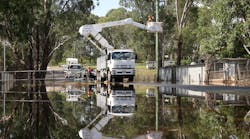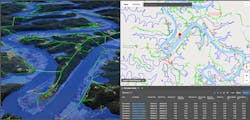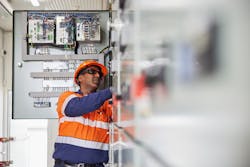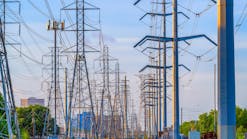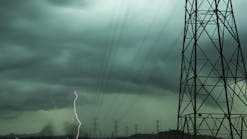Millions of people in Sydney, Australia’s Greater West and beyond rely on Endeavour Energy to provide a safe and reliable electricity supply around the clock. Despite the challenging conditions of the region’s harsh environment — subject to heat waves, flooding, drought and wildfires — Endeavour Energy has embraced technology to continue powering Australia’s third largest economy to a brighter future.
With an estimated value of AU$6.7 billion (at the time of this writing), Endeavour Energy’s network spans more than 25,000 sq km (9653 sq miles). It is made up of more than 430,000 power poles and streetlight columns, 207 major substations and 32,600 distribution substations connected by nearly 60,600 km (37,655 miles) — more than the distance from Sydney to London and back — of underground and overhead cables. It also integrates with renewable energy sources, including 220,000 residential solar connections, industrial solar and embedded large-scale batteries. To make agile decisions to manage its vast network, Endeavour Energy has embraced an engineering-grade digital twin to support delivery of a safe, reliable, secure and affordable electricity supply to more than 2.6 million Australians.
Digital twin technology is used across many different industries. For power utilities, digital twins can now create a 3-D model of the network to optimize investments, identify and mitigate risk, and streamline operations. Endeavour Energy adopted digital twin technology from Neara. Whereas many digital twins provide a lot of detail at a small scale, or little detail at a large scale, Neara’s engineering-grade model provides granular detail but on a large scale — enabling complex engineering-grade analysis automatically across the entirety of a whole network.
Extreme Weather Response
Endeavour Energy already has seen the power of digital twin technology, especially when it comes to extreme weather events, an issue that wreaks havoc not only on utilities in Australia but also in the U.S. and other countries around the world. In March 2021, parts of Greater Western Sydney were inundated by 1-in-50-year floods, resulting in significant customer outages and damage to power infrastructure across the Endeavour Energy’s network.
At the time, the utility was using the Neara platform to accelerate its design process and fast-track ratings studies. When the flood emergency occurred, the utility approached Neara for an urgent and immediate solution to understand the impact of floods on customers, communities and the network.
Leveraging the digital twin, the Neara team implemented a floodwater simulator using open-source government data to model the impact of rising floodwater and keep customers and workers safe. This simulation meant Endeavour Energy could more accurately isolate electricity supply ahead of areas being inundated or where floodwater brought people too close to live power lines.
Network-wide reports on flood activity were visible and editable in the utility’s digital twin instance within 48 hours of the emergency commencing — when the floodwater was still rising. As the floodwater subsided, Endeavour Energy used flood mapping features to prioritize inspections to restore power to customers safely and quickly as well as understand potential hazards before emergency crews were sent into flooded areas.
Accurate Data Classification
One of the most important things when it comes to disaster response is preparation. To prepare, utilities need to understand exactly where their network assets are and assess the risk for each. Following the flooding incident, Endeavour Energy was able to explore the full capabilities of its digital twin, which starts with accurate light detection and ranging (LiDAR) data classification. In its work with utilities, Neara has discovered hundreds of instances where discrepancies exist between documented records and actual asset locations in the physical world. Having accurate network topology and a detailed 3-D model of electrical infrastructure is the first step in effective preparation for extreme weather events.
As a result, Endeavour Energy has worked to incorporate data from multiple sources across its business into the digital twin platform to build its most accurate 3-D digital model yet. An accurate model enables the utility to manage its critical infrastructure with greater insight, so it can deliver enhanced operational efficiency and better reliability outcomesfor its customers.
Identify At-Risk Assets
Using Neara’s physics-enabled software, Endeavour Energy can assess where assets are at risk from multiple factors, including high tension and encroachment risk. With this information, the utility can identify high-risk and high-priority areas of its network when simulating extreme weather events — such as high wind, extreme heat, rising floodwater and wildfire — to understand the impact on its network. For example, the utility can see how cables might sag in hot temperatures, which feeders might be impacted first as floodwater rises and which poles might be most at risk of failure in high winds.
With safety being Endeavour Energy’s No. 1 priority, performing grid-hardening activities are a must. Prioritizing these investments based on the intelligence gathered by running a multitude of risk-planning scenarios and simulations using the digital twin is game changing. However, identifying weather-related risk is not the only thing Endeavour Energy is doing with this technology.
Vegetation Management
Vegetation management is an ongoing responsibility for utilities with overhead infrastructure. LiDAR data captures network assets and vegetation. Once the data is classified, the result is an extremely accurate representation of network assets and the objects around them.
Unlike buildings, vegetation grows and changes over time. Not only must utilities ensure vegetation, such as trees, does not grow into power lines, they need to ensure the vegetation does not present a fall-in risk. Neara’s digital twin includes a physics-based calculation to determine whether nearby trees might fall onto a power line, and these are highlighted across the whole network, so engineers and contractors can easily identify and prioritize hazardous tree removals.
Replace And Maintain Assets
Endeavour Energy has been able to deliver more efficient asset replacement and maintenance regimes using the digital twin. With high-quality LiDAR data captured by most utilities to understand vegetation encroachment, the next logical step is to use the data to extract more value by applying it to other use cases. With its interactive 3-D digital model, Endeavour Energy has been able to understand loading scenarios, so it can optimize asset maintenance workflows.
Many utilities know roughly where their poles are, but they often do not have detailed records of pole-top equipment such as crossarms and insulators. Having a rich asset database allows for better asset replacement strategies by prioritizing the highest-risk and highest-impact assets and tackling them prudently. This removes much of the guesswork and wasted resources on lower-priority asset replacements.
Invest in the Modern Grid
With so much time and money saved with the efficiencies introduced by the digital twin, Endeavour Energy can invest more time on strategizing for the future. The utility is committed to planning a modern grid where batteries, microgrids and solar integrate seamlessly with the distribution network’s traditional poles and wires.
With its design capabilities, Neara’s software and digital model is helping the utility’s engineers to design and modify the infrastructure needed to allow for this integration. By first designing digitally and stress testing the 3-D model in a risk-free environment, Endeavour Energy can ensure the decisions it makes are right the first time with new construction projects.
Utilities in the U.S. can learn a lot from the success Endeavour Energy has had so far using digital twin technology. There is even more to be had, as the utility is just getting started. With U.S. networks facing similar challenges and utilities working hard to modernize and future-proof their infrastructure, a digital twin offers significant potential to improve customer and business outcomes.
Scott Ryan (https://www.linkedin.com/in/scott-ryan-0851621/) is a senior executive with a track record in transforming people and business to provide a step change in organizational performance. As Endeavour Energy’s Chief Asset and Operating Officer, Ryan has responsibility for grid transformation, asset management and delivery operations for the safe and reliable supply of electricity to over one million customers. His team consists of 1,100 staff comprising backgrounds such as engineers, project managers, technicians, designers and field staff. He brings a deep knowledge of the energy industry to the executive team, having started career as a cadet engineer and worked in many aspects of the business including asset management and operations, regulatory and retail. Ryan’s people leadership capabilities have led to major reform of our workforce and business across areas such as safety, reliability, delivery, productivity and customer focus. In addition, he also established the successful unregulated growth business Ausconnex, leading the entire end-to-end operations from business development
to delivery, growing revenue 25% - 70% year on year across a three-year period.
For More Information
Neara | www.neara.com
Scott Ryan
Scott Ryan started as a cadet engineer at Endeavour Energy and has a wealth of experience in the energy industry. Now as a senior executive with the utility, he has a track record in transforming people and the business to provide a step change in organizational performance. He brings a deep knowledge of Endeavour Energy to the executive team, having worked in many aspects of the business, including asset management and operations combined with commercial experience in regulatory and retail. Ryan’s people-leadership capabilities have led to major reform of the utility’s workforce and business across areas such as safety, reliability, delivery, productivity and customer focus. In addition, he also established the successful unregulated growth business Ausconnex, leading the entire end-to-end operations from business development to delivery, growing revenue 25% -to 70% year over year across a three-year period. In his current role as chief asset and operating officer, Ryan has responsibility for grid transformation, asset management and delivery operations for the safe and reliable supply of electricity to more than 1 million customers. His team consists of 1100 staff comprising backgrounds such as engineers, project managers, technicians, designers and field staff.
